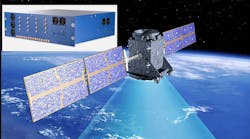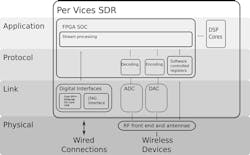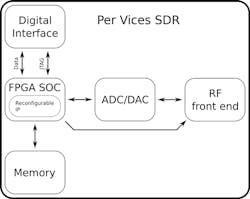The Value of SDR Integration Across Industries
What you’ll learn
- The different elements that make up software-defined radio architecture.
- What are the five applications that really benefit from SDR?
- The benefits of SDR in terms of its configuration flexibility.
Software-defined radio (SDR) is a radio communication and signal-processing system in which certain functions typically carried out by hardware components are instead performed by software. Replacing specific hardware with software creates a flexible, high-performance system that’s unattainable by hardware-only systems.
An SDR typically consists of an SDR platform and a computer or embedded system containing appropriate software. SDRs come in various flavors with a wide range of capabilities. While functionality is controlled by software, the level of capability depends on the given SDR platform.
The essential functions of SDRs are receiving and transmitting radio signals and, in some systems, digital signal processing. SDRs capable of transmitting or receiving only are called transmitters or receivers, respectively, while SDRs that perform both functions are called transceivers.
SDR Architecture
SDR architecture comprises the following:
The radio front end (RFE) contains most of the components that have been replaced with software. The configurable RFE of SDRs is what gives them their flexibility and versatility. Components in the RFE include filters, mixers, amplifiers, variable-frequency oscillators/tuners, and I and Q converters. In radio-frequency (RF) reception, these components are responsible for setting the SDR to the right band, frequency, and bandwidth, as well as for preparing the received signals for analog-to-digital conversion. In RF transmission, the RFE prepares signals converted from digital to analog for transmission at the right frequency.
The analog-to-digital converters (ADCs) in a receive-board radio chain converts the I and Q signals received from the RFE to digital signals that can be processed by the digital signal processor (DSP). Digital-to-analog converters (DACs) are used in transmit-board radio chains to convert digital signals from the DSP to analog signals.
The DSP processes received signals into data before sending them to the host computer. It also processes data from the host computer into signals that can be transmitted. Data is transferred between the DSP and the host system via digital backhaul. Depending on the SDR platform, the DSP may be implemented using field-programmable gate arrays (FPGAs), a hard processor system (HPS), application-specific ICs (ASICs), or a combination of more than one of these.
In some SDR systems that don’t have DSPs, digital signal processing is carried out by the host computer's processor.
In receive-board radio chains, the host system is at the end of the chain. It presents the data contained in the received signals. This could be via data processing, imaging, payload decryption, tracking, and many others. The host system in transmission chains prepares the data to be transmitted before sending it to the DSP. See Figures 1 and 2 for block diagrams illustrating the roles of SDR architecture.
Applications of SDR
Because of their high functionality and capabilities, which include broad frequency range, high bandwidth, and advanced signal processing, SDRs are found in applications across numerous fields and industries. These include medical, aerospace, broadcasting, defense, civil communication, and virtually all fields that employ radio technology. Five specific applications for which SDR is immensely beneficial and indispensable are radar, MRI, GNSS, test and measurement, and low-latency links.
SDRs are used in radar applications as transmitters, receivers for returning signals, and DSPs. They can also be configured to work as transponders that only transmit signals when triggered by incoming signals. SDRs are used in primary and secondary radars, general pulse radars, maximum range resolution radars, and the like.
Magnetic resonance imaging (MRI) employs SDR to generate and transmit the radio waves needed to excite low-energy water molecules in the human body. SDR is also responsible for receiving and processing the return waves before forwarding the data to a computer for imaging.
In Global Navigation Satellite System (GNSS) applications, SDR receivers on a device receive signals from satellites in a satellite navigation system's constellation. The DSP processes the received signals to calculate the device’s position. SDRs are employed in GNSS for locating and tracking missiles, drones, aircraft, vehicles, and more.
After setting up a radio system, it’s necessary to thoroughly check that all operations are going smoothly. The same goes for manufactured equipment. SDRs are used to test various radio equipment and systems, reducing development time and time to market.
SDRs are use used to set up low-latency links for wireless point-to-point communication systems. The use of SDRs helps reduce receive and transmit latency as well as round-trip latency.
The features of SDR have numerous advantages and benefits in the above-listed applications. Three key beneficial features of this technology are the architecture, configuration, and bandwidth. These features of SDR and their advantages in the applications listed above are explained below.
Architecture Benefits of SDR
Advanced radio applications usually require various large pieces of equipment working simultaneously to perform the numerous operations involved in receiving, transmitting, and processing radio signals. Such systems are complicated, chunky, and costly to set up, run, and maintain, and may be susceptible to inefficiencies.
SDRs provide fully integrated and highly compact systems with both RF and digital processing resources. These systems are more capable, functional, cost-effective, efficient, and easy to manage. Among the advantages of SDR architecture in popular applications are:
- For radar applications, a fully integrated SDR system can be used as a radio receiver, radio transmitter, digital signal processor, or a combination of all three. The DSP also provides waveform storage in addition to digital signal processing.
- In MRI, SDR architecture can serve as both a pulse generator (exciter/radio transmitter) and a digital receiver (RF acquisition/radio receiver). It also allows for easy integration into existing systems, as well as external and internal triggering.
- In GNSS applications, SDR provides radio receiver and transmitter resources. Various satellite navigation systems are in use today, including GPS, GLONASS, Galileo, and BeiDou. These systems employ different constellations to function. The FPGA resources of SDRs are flexible enough to implement different constellations. This means that a single device affords access to various satellite navigation systems.
- SDR architecture is also very useful for test and measurement applications—it can be used to test both radio and digital devices. The same system can serve as receiver, transmitter, oscilloscope, signal generator, network analyzer, power meter, spectrum analyzer, and more for testing telecommunication, aerospace, military, and other radio equipment systems.
- Processes in a radio chain such as mixing, filtering, signal conversion, and signal processing all contribute to latency. Having all RF and digital processing components in one system helps reduce overall system latency. An integrated system also allows for modem operation on FPGAs and offers a direct network connection through the digital interface. These result in faster data transfer and processing.
Configuration Benefits of SDR
Radio technology has numerous applications that require different configurations. Each of the applications being discussed are broad and may require a wide range of settings. In traditional systems, changing settings such as frequency band, bandwidth, number of channels, and receive and transmit chains may require new systems or equipment. With SDRs, however, only a simple change via software is required to create different systems.
If the need arises, an SDR's configurable RFE makes it possible to use a single piece of flexible hardware for an extensive range of applications by simply updating the software later on. SDRs have digitally controlled attenuation, adjustable bandwidth, and flexible operating frequencies, among other parameters. There are multiple configuration benefits of SDR particular to radar, MRI, test and measurement, GNSS, and low-latency links applications. For instance:
Different radar applications utilize various bands in the radio spectrum. Airport surveillance radars, for example, operate at frequencies in the S-band while marine radars operate at frequencies in the X-band. Having a configurable RFE makes it possible for the same SDR platform to be used in different radar applications as bands can easily be adjusted.
The RF range used in MRI depends on the magnetic-field strength and is usually between 1 and 300 MHz. The configuration features of SDR allow for flexible operating frequencies in MRI applications.
Furthermore, satellite navigation systems make use of various bands. Some systems utilize different frequencies within the same band. GPS, for example, operates at frequencies in the L1, L2, and L5 bands. SDRs can be configured to operate at various bands; thus, one platform can be used for various SatNav systems.
New radio equipment is continually being manufactured. It’s crucial to thoroughly test such equipment for various applications. In traditional systems, a new radio system or some new hardware would need to be designed/acquired for every new device/protocol being tested. A simple change of software is all that’s needed when using SDR. Configurable SDRs can be used to test multiple devices operating at different frequencies, such as HF, UHF, VFH, and so on.
In low-latency links, configurable RFEs provide considerable control in reliability vs. latency tradeoffs. They also make it possible to transmit and receive at optimal frequencies by tuning to the least-congested band. Furthermore, filtering can be implemented to improve signal-to-noise ratio.
Bandwidth Benefits of SDRs
SDRs have several bandwidth benefits. They can transmit and receive signals at much higher bandwidths than traditional radio systems. This allows them to handle different sizes of data in different bands. SDRs also feature adjustable RF bandwidth, making the amount of transmittable and receivable data variable.
Such precise adjustment is key in several applications. Because they’re able to operate across multiple bands simultaneously, SDRs can be used to tune to all required bands in an RF application simultaneously, eliminating the need for separate radio chains. Adjustable bandwidths also make it possible to test equipment operating at different bandwidths and over various bands without limitations.
Conclusion
SDR offers numerous important benefits in various applications, and it’s still undergoing development for even more applications. The technology greatly improves the capacity, speed, and cost-effectiveness of any application to which it’s applied.
Multiple manufacturers make many types and models of SDR. These can vary widely in capability, functionality, and application. As a result, it’s crucial to select the SDR platform that best fits all your current and anticipated future needs.
John Polak is RF hardware designer for SDR at Per Vices Corp. and Etiido Maurice Uko is a Mechanical Engineer.


